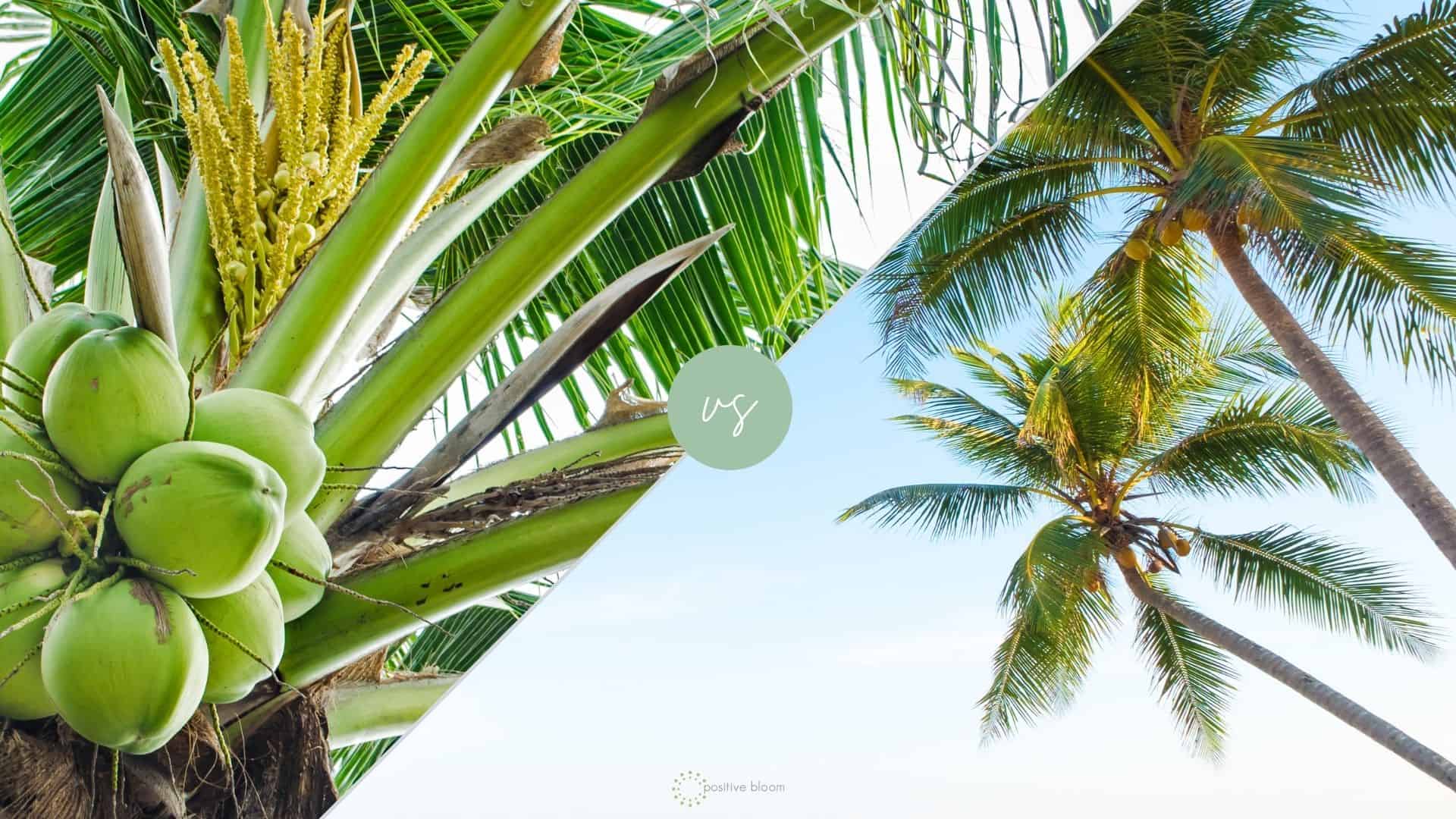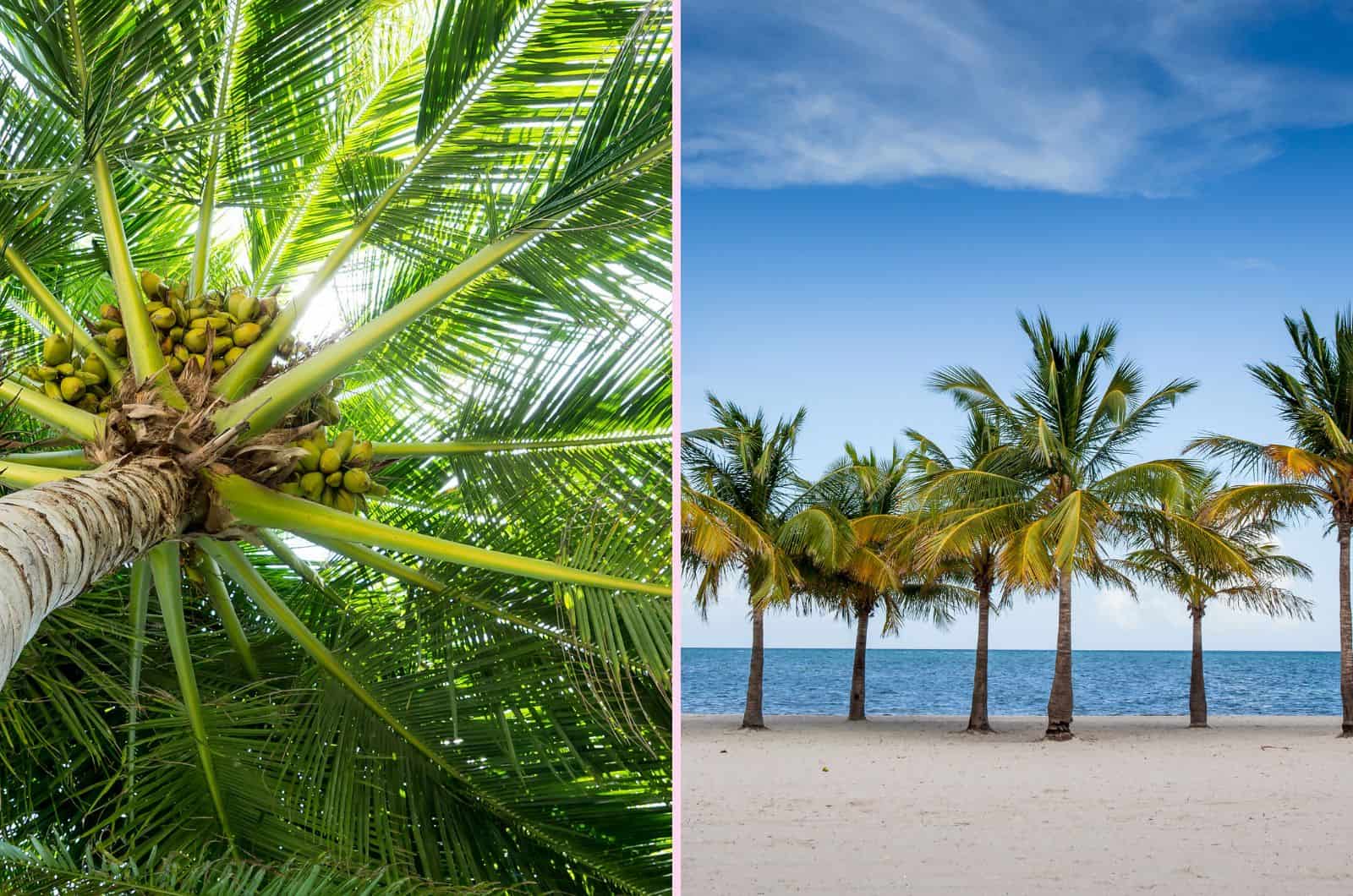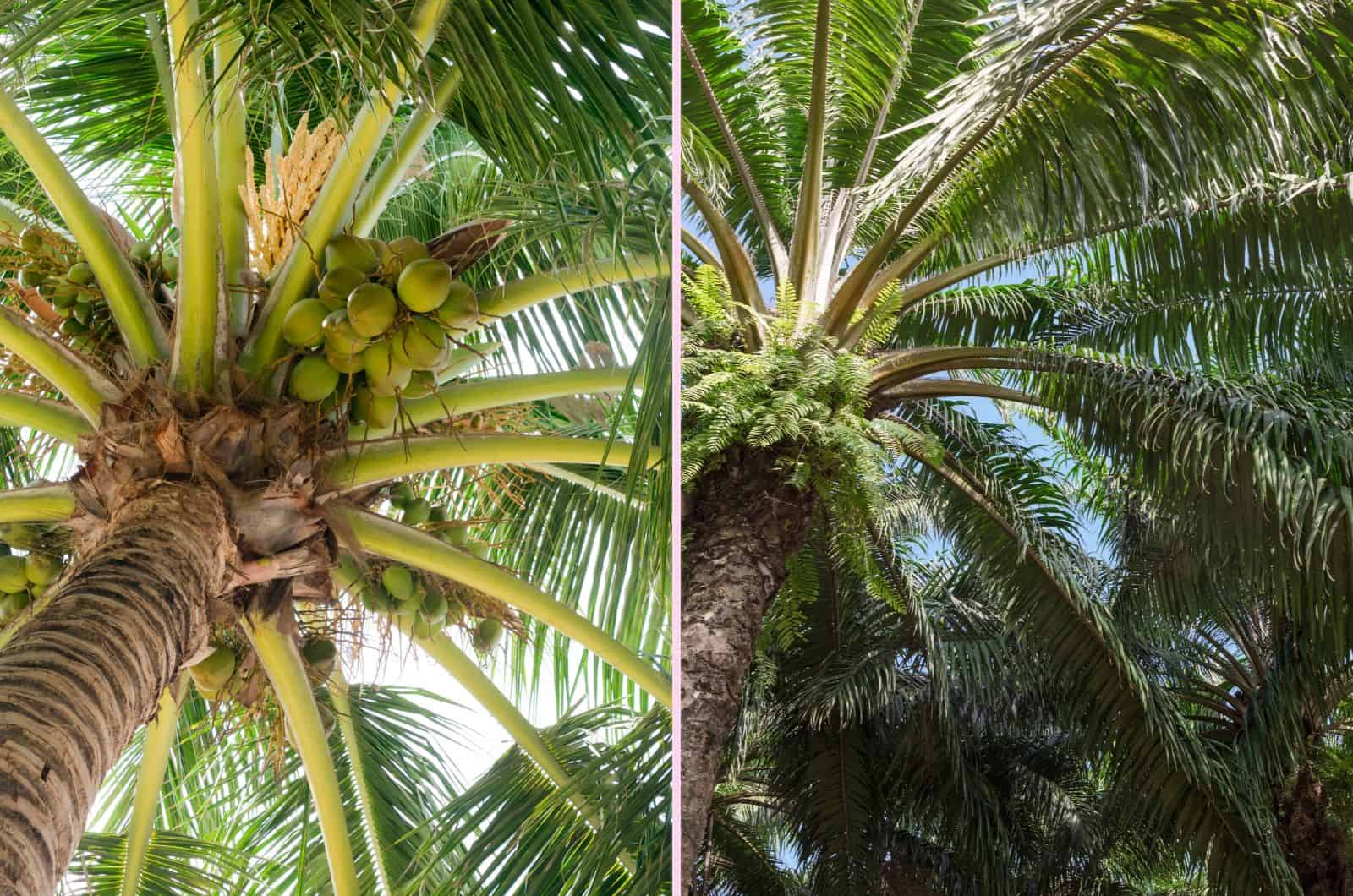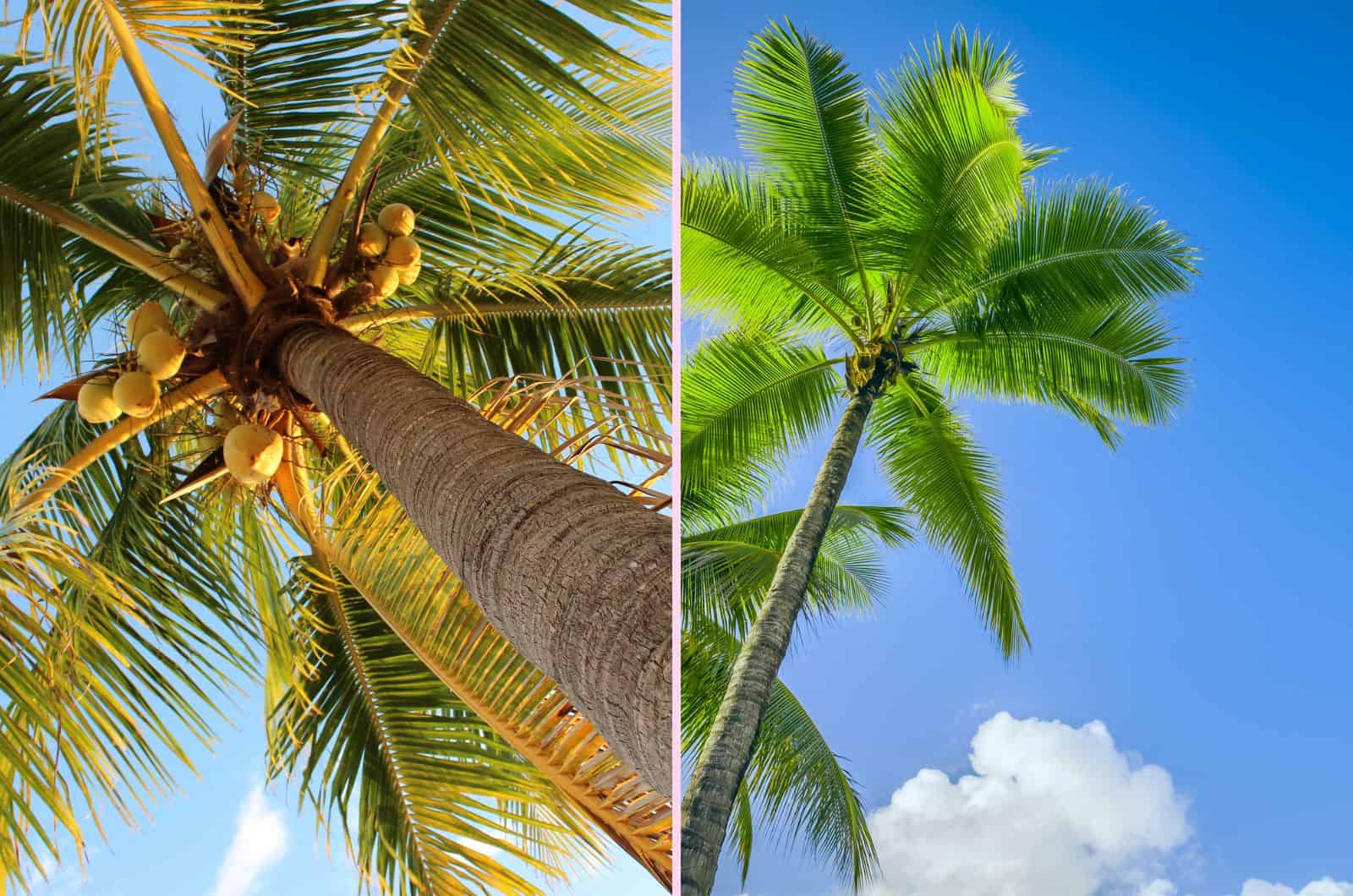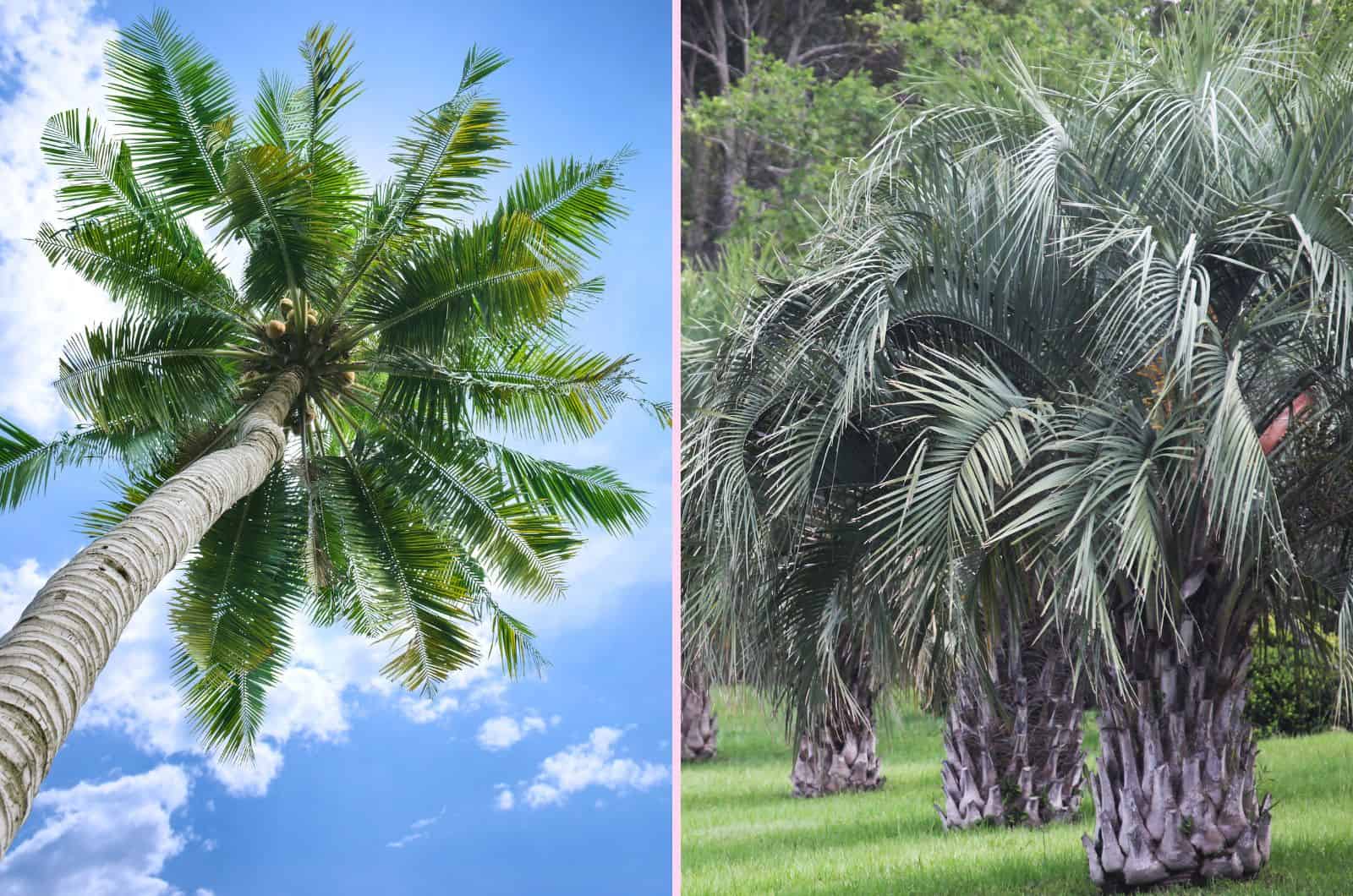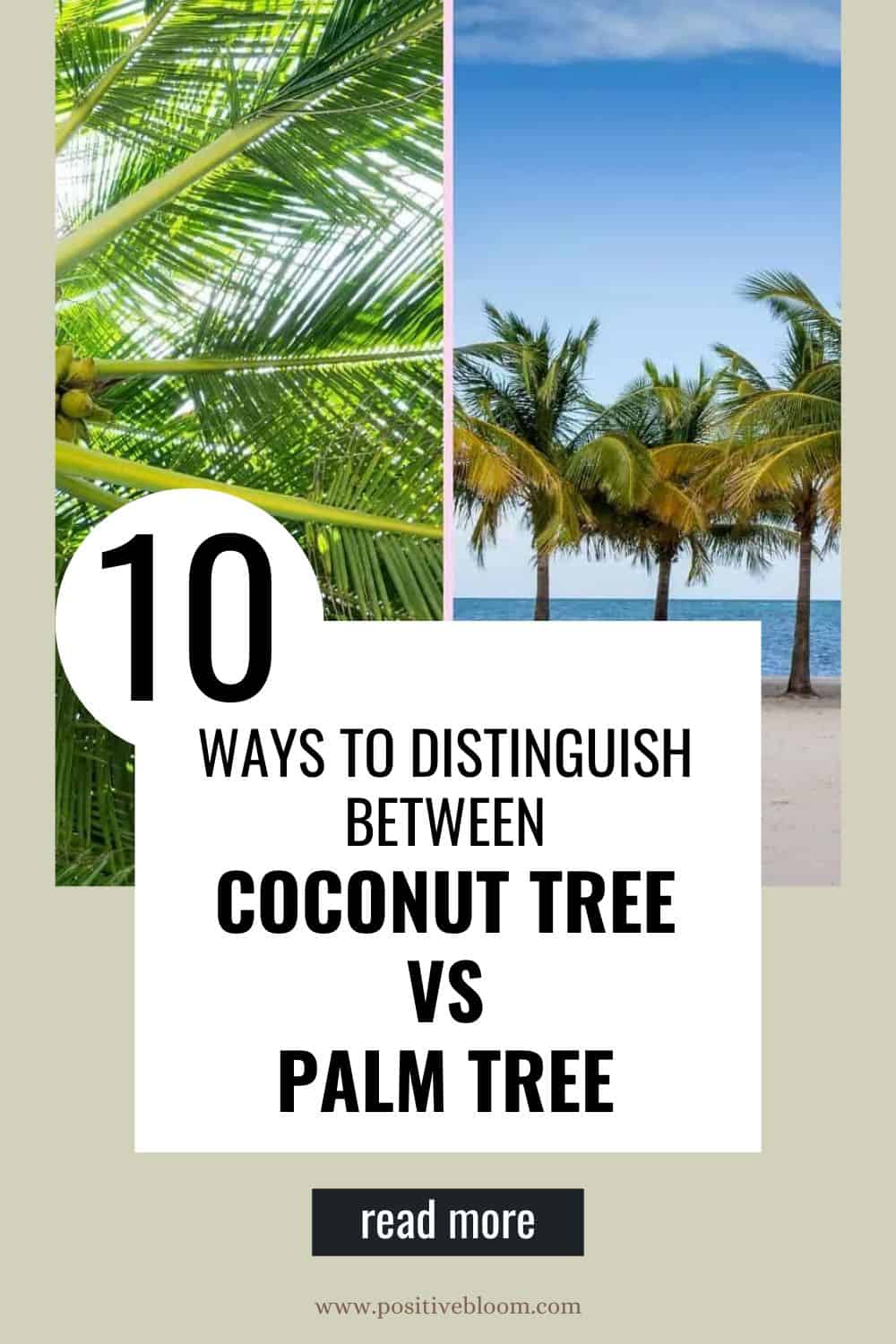Palm trees are one of the best ways to give your home a tropical vibe, but how do you decide which one to get? There are so many varieties that it’s nearly impossible to settle upon a single one.
And to top it all off, people complicate things with their coconut tree vs palm tree advice; this one is better, that one can fit in your house, this one is more suitable for your climate…
And even if you get both of them, they look virtually the same, so it just seems like you’ve bought the same plant!
Or does it? There are certain elements that divide coconuts and all other types of palm trees, and we’ll discuss them in the article below.
Here are some of them:
| Coconut tree | Palm tree | |
|---|---|---|
| Family | Arecaceae | Arecaceae |
| Fruit production | Coconut | Dates, nuts, and other fruits; but some palms don’t bear fruit |
| Oil | Coconut oil | Palm oil |
| Trunk | Smooth texture | Scaly texture |
| Leaf shape | Pinnate leaf | Fan-shaped leaves |
| Roots | Strong and deep roots | Shallow fibrous roots |
| Native habitat | Western Pacific islands | Tropical regions of Americas, Asia, and Indonesia |
| Light Requirements | Full sun | Full sun and partial shade |
| Water | 15-30 gallons a day for grown plants; water indoor plants when the topsoil dries | 15-30 gallons a day for grown plants; water indoor plants when the topsoil dries |
| Humidity | High humidity | High humidity |
| Soil | Well-draining | Well-draining |
| Fertilizer | Slow release fertilizer for in-ground plants; liquid fertilizer for potted plants | Slow release fertilizer for in-ground plants; liquid fertilizer for potted plants |
| Growth rate | 2-3 feet a year (5 feet a year when young | Most species grow 3-10 inches a year, but some can grow 6 feet annually |
| Size | 60-100 feet | Approximately 15-30 feet, but some varieties can get 200 feet tall |
| Lifespan | 60-80 years | 70-100 years, but some types can live up to 150 years |
| Usage | Ornamental and for fruit | Ornamental and for fruit |
Coconut Tree vs Palm Tree
When we lay our eyes on the majestic king palm tree, we expect to see coconut fruit hiding in the fronds. And we get so disappointed when there aren’t any!
Well, coconuts are just one type in a vast sea of varieties of palm trees that produce a unique fruit. Therefore, the main difference between coconut and palm trees is in fruit production, oil production, leaf shape, roots, trunks, size, preferred climate, light needs, lifespan, and growth rate.
We’ll discuss each of these differences in the following sections, so stick around!
Fruit Bearing
Coconut trees produce coconut, a signature round nut with husk we’re all familiar with. However, most other palms don’t bear fruit.
Of course, there are palm trees which produce fruit, such as the queen and date palm, but those are definitely not hard coconuts with a husk and delicious coconut water and flesh inside.
Oil (Coconut And Palm Oil)
Another thing that helps us distinguish these species of palm trees is the oil. Coconut palm produces coconut oil, or rather, we use the coconut fruit to make it.
Other palms produce palm oil (which is extracted from palm fruit), and the one which is the primary source of this ingredient is African oil palm.
We use both products in cooking, but coconut oil is generally considered healthier and has more benefits since it is richer in nutrients.
Tree Trunk
One of the major physical differences between these two varieties is in their trunks. Palm tree trunks can be described as scaly trunks, whereas the ones from coconuts are fairly smooth in comparison.
Palm tree species generally have darker skin than coconuts, but there are so many different palms that it might be difficult to tell the difference sometimes.
Also, coconut palms have thick trunks, whereas trunks of other varieties of palm trees may vary from tall, thin, and reedy to really bulky, stocky, and thick.
Leaf Shape
The main difference between the fronds of coconut and other palm species is that palm trees usually have fan-shaped leaves.
Other than that, palm tree leaves are no different in size, texture, and color than the pinnate leaves of coconuts.
Finally, there are various palm species, so we can’t claim anything with absolute certainty. For instance, date and queen palm trees have pinnate foliage, just like coconut trees, whereas areca and parlor palms have those signature fan-shaped fronds.
Roots
Typical palm trees have shallow fibrous roots that don’t extend deep or wide into the soil, which is why removing palm tree stumps isn’t too complicated.
But coconut palms have strong roots that reach deep into the soil and only strengthen over time. They developed them to endure the strong winds of tropical climates, such as monsoons and typhoons.
Native Habitat And Climate
Both plants thrive in tropical regions, but coconut trees are less tolerant of dry and cold weather than some other palm species.
Coconut trees are native to the western Pacific islands. In the United States, they can tolerate the climate of the southern regions of Florida.
Palm trees, on the other hand, have a broader habitat and are native to subtropical and tropical regions of North and South America, Indonesia, and Asia.
Light Requirements
Even though coconut trees are technically palms, they don’t have the same light requirements. The coconut palm requires full sun conditions for the best growth and an abundant harvest.
Most other palm trees can flourish in bright indirect light, making them perfect for indoors. However, you shouldn’t keep them in the shade all the time since one of the leading causes of dying palm trees is inadequate lighting.
Growth Rate
Coconut palms have moderate growth and generally grow about 2-3 feet a year. However, it can put on as much as 5 feet per year when it’s still young.
Most other palms have a slow growth rate and put on 3-10 inches yearly. But some species develop much faster than this, such as the king and queen palm trees, which put on 2-3 feet annually, and the carpenteria, which grows incredibly fast (6 feet a year).
Size
Coconut trees can get 60-100 feet tall and 20-30 feet wide if their growing conditions are absolutely perfect.
Other palm trees are more varied; some tall palms can get 200 feet tall, while others are usually between 15 and 30 feet tall.
Lifespan
Coconut trees usually live between 60 and 80 years, which is why they are also known as three-generation trees.
Palm trees, on the other hand, can live much longer – between 70 and 100 years in their native habitats. Of course, some varieties can last up to 150 years, but those aren’t the majority of this plant species.
Coconut Tree vs Palm Tree: Similarities
We discussed some major things that divide the coconut tree vs palm tree, but now it’s time to discover some things that connect them.
Both plants come from the same category, can thrive in the same soil conditions, and have similar moisture needs.
We even use both plants for the same purpose – landscaping!
Family
Every single palm tree, including coconuts, belongs to the family Arecaceae. This family is frequently called Palmaceae, but professionals and academics do not accept this name.
The botanical name for the coconut tree is Cocos nucifera, while palm trees have various names, such as Phoenix dactylifera for date palm, Dypsis lutescens for areca palm, etc.
Water And Humidity Requirements
Both plants require a lot of water, especially if you grow them in soils with fast drainage. Established coconut and palm trees grown for fruit-bearing purposes might require up to 15-30 gallons of water each day.
However, if you grow these plants indoors, they’ll need much less moisture because they won’t bear any fruit (most likely), and you should only irrigate them once their topsoil dries out.
Also, the size and the growing conditions affect the watering frequency and amount. For instance, if you live in rainy climates, you won’t have to water your palm trees too often.
These plants also require high humidity, so use a humidifier if you grow them indoors, and regularly mist them if air moisture levels are below 40-50%.
Soil And Fertilizer Requirements
All palm trees can grow in slightly acidic and sandy soils, including coconut trees, but that doesn’t mean you can just plant them in the sand.
Even the beach growing medium contains the necessary nutrients, silt, and clay. These materials provide some moisture retention and keep palm trees hydrated.
But what should you do if you want to grow these plants at home? Just get a potting mix for palm trees, and your fronded buddies will be healthy and thriving. You can also mix some perlite, vermiculite, or sand to make it more draining.
Finally, plant them in containers with potholes or raised garden beds for optimum drainage.
Fertilizer
When it comes to fertilizing these plants, simply use a high-quality fertilizer and follow the instructions. Large trees require much more food, so make sure to get the measures correctly.
Also, potted trees would benefit from regular fertilization with a liquid fertilizer, while in-ground varieties prefer slow-release fertilizer twice a year.
Usage
We can use both plants for landscaping and grow both varieties indoors and outdoors. It might seem a bit strange to grow coconut palm trees inside the house, but there are dwarf varieties that can fit amazingly.
Of course, some growers nurture coconut trees for their fruit, but you can do that with queen palms and date palms as well; their fruit is delicious!
How To Identify Different Coconut Palm Trees
Now we know the differences between coconut and palm trees, it’s time to learn how to distinguish different types of coco palms.
Well, there are two main categories of coconut palms: tall and dwarf coconut trees. Aside from their noticeable difference in size, these two species also differ in terms of pollination. Tall coconuts usually cross-pollinate, whereas dwarf varieties self-pollinate.
Here are some famous coconut varieties:
Malayan dwarf coconut – produces 50-60 coconuts a year and starts bearing them approximately 3-4 years after planting (and is also resistant to the lethal yellowing disease.).
Fiji dwarf coconut – best for landscaping in humid climates due to the gorgeous long fronds and leaflets and high resistance to the lethal yellowing illness.
Tiptur tall coconut – it is among the best types because it bears around 70-80 coconuts per year and starts producing them about six years after planting.
King coconut – you can easily recognize this tall coconut by its orange fruit, which is very nutritious (contains vitamins, carotenoids, amino acids, etc.); it produces 60-80 coconuts annually.
How To Identify Different Palm Trees
There are approximately 2,600 palm tree species that we know of. We cannot describe all of them, but we can mention some interesting and common ones.
Below, you can read more about areca, pindo, date, queen palm, and more.
Queen Palm
This variety can grow up to 50 feet and extend its fronds about 20-25 feet, so it’s a perfect addition to outdoor decor. Its gray tree trunk provides a nice contrast to dark fronds that reveal tiny orange “berries” in the winter season.
Date Palm Tree
Date palms usually get around 75 feet tall and can be quite valuable, as well as beautifully decorate your landscape. This tree produces deliciously sweet fruit (dates) that appears around April or May and ripens in August and September.
Areca Palm
This species usually reaches around 20 feet tall, but it’s traditionally grown indoors, where it gets about 8 feet tall max. It also produces areca nuts, but it is highly carcinogenic and should not be consumed, chewed, etc.
African Oil Palm
This variety is frequently referred to as simply oil palm, and it is the primary source of palm oil. It gets around 65 feet tall and produces clusters of plum-like fruits which blacken as they mature.
Pindo Palm
The arching and evergreen fronds of this species are an excellent way to spruce up your garden. The tree isn’t too tall, and its 20 feet of height won’t take up all the space in your yard. It also produces tiny orange fruits that you can eat fresh, use to make jams and jellies, or add to wine.
Final Thoughts
The main differences between the coconut tree vs palm tree are in their fruit and oil production, size, trunks, leaf shapes, roots, climate and light requirements, growth rate, and lifespan.
Coconut trees produce coconuts which are used to make coconut oil, while palm trees produce different fruits such as dates, nuts, etc., some of which can be turned into palm oil.
Coconut trees live shorter lives and have deeper roots and pinnate leaves, while palm trees are more diverse. They typically grow much slower than coconuts, but some species can grow faster. They can also get much taller than coconut palms, but their average size is shorter than coconuts’.
But there are also similarities between the two. We use them for similar reasons, they come from the same family and have the same water, soil, and fertilizer needs.
Finally, we examined a couple of coconut and palm tree types so that you can find the right fit for your yard.
Enjoy the tropical vibes, and until next time!
Like this post? Share or pin it for later!

